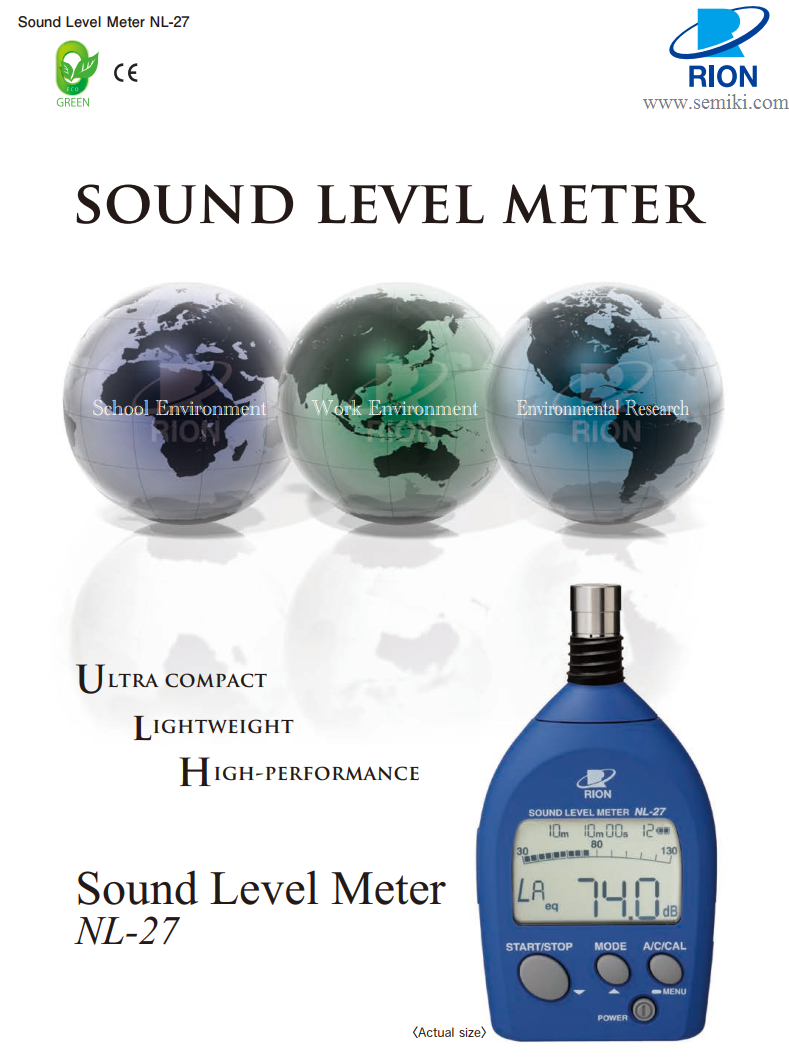
1. What is sound?
Sound is generally defined as a wave (acoustic, elastic wave) that propagates through media such as gases, liquids and solids. This guide will primarily consider sound waves propagating through air. Sound waves, which travel at a speed of approximately 340 m/s, are a wave phenomenon. We hear these waves as they travel through air. These waves are produced when the atmospheric pressure of the air continually fluctuates (i.e. alternating pressure fluctuations). Pressure fluctuations that are far from atmospheric pressure (static pressure) are commonly referred to as sound pressure. The following are excerpts from IEC 60050-801 (JIS Z 8106:2000).
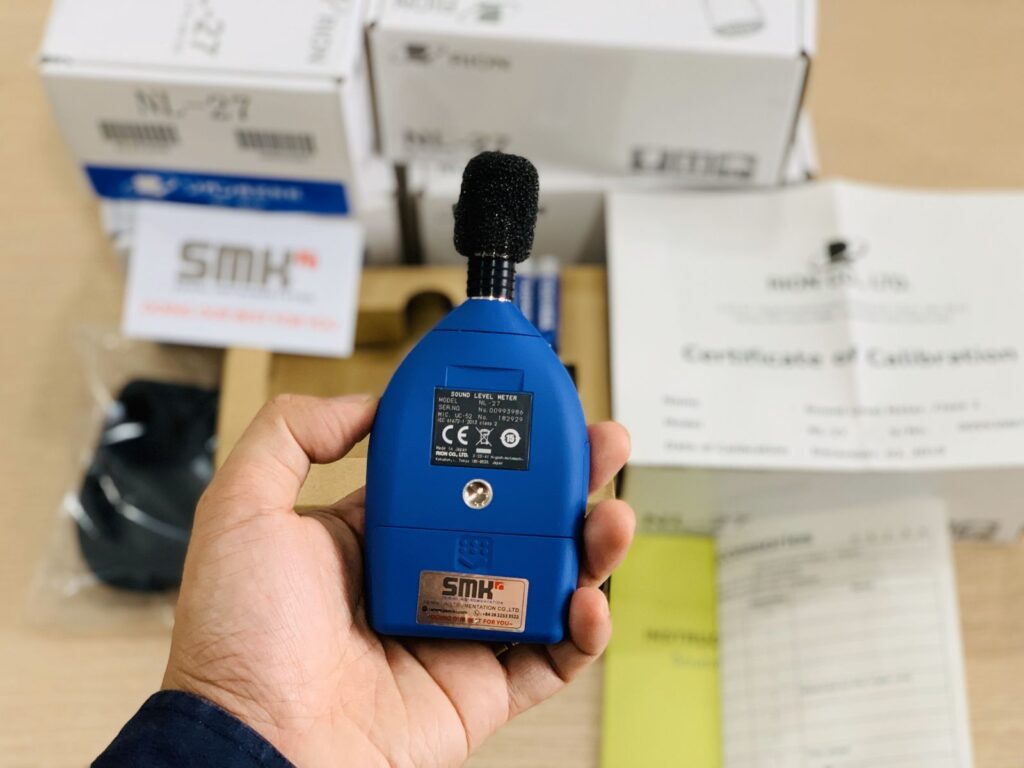
CLASS 2 SOUND LEVEL METER – RION NL-27
Sound pressure:
The mean square value of the instantaneous sound pressure over a time interval unless otherwise specified
| As shown above, the IEC standard (JIS) clearly distinguishes instantaneous sound pressure from sound pressure (see Figure 1-1). Please note that in this manual; the term “sound pressure” refers to “sound pressure” or “instantaneous sound pressure” as defined in IEC 60050-801 (JIS Z 8106:2000), whichever is appropriate. A person with normal hearing can hear a range of sound pressure from 20 µPa to 20 Pa. The symbol µ, meaning microphone, is used to denote 10 -6 . This means that the loudest sound that can be heard is 10 times louder than the quietest sound that can be heard. 6 times. Pa is the unit of pressure. 1 Pa corresponds to the pressure obtained when 1 N (weighing about 0.1 kg) is applied to an area of 1 m 2 . The atmospheric pressure used in weather forecasting is expressed in hPa, which is 100 times larger than 1 Pa. (1 atm is about 1013 hPa.)Similar to sound intensity, a young person with normal hearing can hear instantaneous sound pressure with a frequency range from about 20 Hz to about 1000 times higher, 20 kHz. Sound can be divided into the following frequency ranges. Below 20 Hz: Infrasound 20 Hz to 20 kHz: Audible sound Above 20 kHz: Ultrasound | 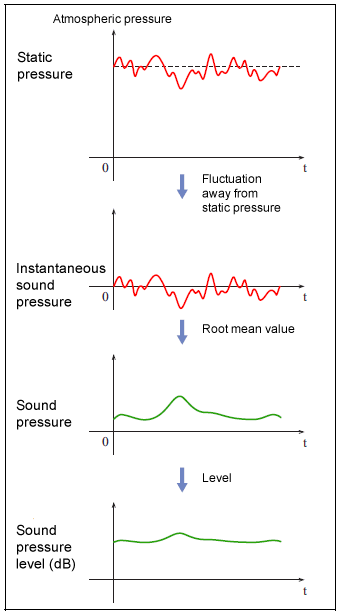 Figure 1-1: Basic processing flow of a sound level meter Figure 1-1: Basic processing flow of a sound level meter |
We distinguish different sounds based on the following characteristics of sound.
| Soccer field: | Pitch is the highness or lowness of a sound, determined by the frequency of the sound. The higher the frequency, the higher the sound. The lower the frequency, the lower the sound. |
| Size: | There is a larger “a” and a smaller “a”, both of which have the same pitch. They have similar waveforms but the larger “a” has a larger amplitude and the smaller “a” has a smaller amplitude. Sound level meters are designed to measure the loudness of a sound. |
| Timbre/Tone: | We can distinguish between different musical instruments even when they produce sounds of the same pitch and loudness. This is because we have the ability to distinguish between different types of timbre and tone. Although both timbre and tone have not been fully elucidated, they are considered to be related to the sound waveform. |
Like waves, sound also has associated effects such as reflection, transmission, and diffraction shown below, which decrease with distance.
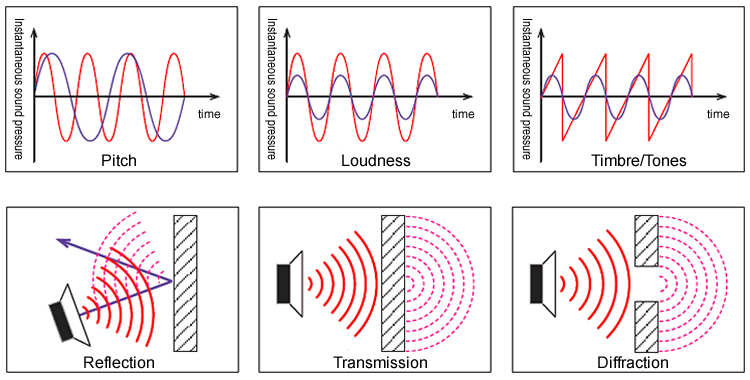 Figure 1-2: Impact of sound Figure 1-2: Impact of sound |
2. What is noise?
Among the various types of sounds, noise is generally referred to as unpleasant and annoying sounds that no one wants to hear. IEC 60050-801 (JIS Z 8106:2000) mentioned earlier in this guide defines noise as unpleasant or unwanted sounds or other disturbances. Unpleasant sounds can be harmful to a person's health and living environment and develop into noise pollution.
Within the audible range of 20 Hz to 20 kHz, noise rating specifically deals with the range of approximately 50 Hz to 5 kHz. In everyday conversations, the range of 300 Hz to 3 kHz is important for hearing. Working long hours in loud noise can damage your hearing. Noise regulations are in place to protect us from noise and help ensure normal life.
Sound level meters are commonly used to measure and evaluate noise. There are two types of sound measurements: physical and perceptual. Physical measurements of sound include sound pressure level, sound intensity level, sound power level, and octave and 1/3 octave bands for frequency analysis. Perceptual measurements of sound include loudness, pitch, timbre, loudness, and A-weighted sound pressure level. Many of these measurements have been defined by the JIS (Japanese Industrial Standards) and the IEC (International Electrotechnical Commission). Perceptual measurements are a growing field of science, with much research having been conducted in the past and yet to be conducted.
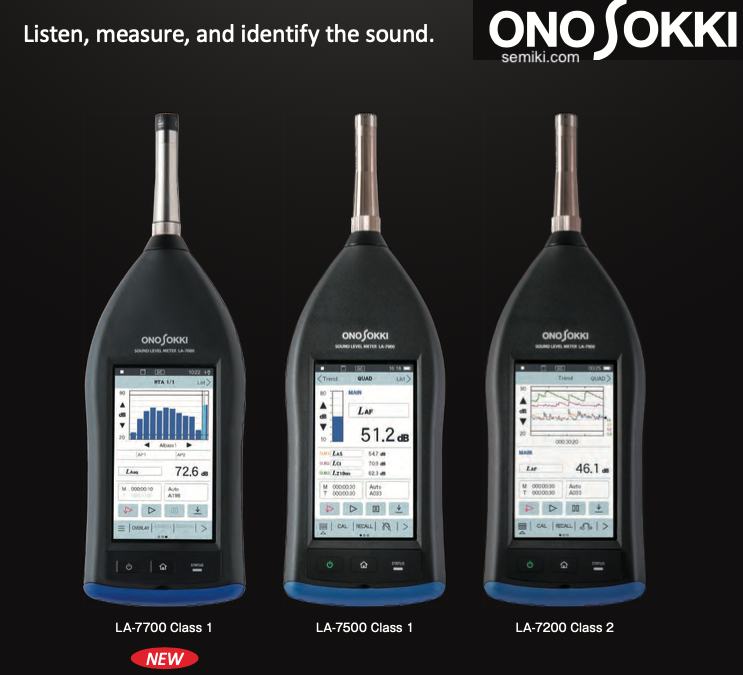
ONO SOKKI LA7200, LA7500, LA7700 Audio Analyzer
Different acoustic measurements are used for different evaluation purposes: A-weighted sound pressure levels for environmental noise assessment; sound power levels and 1/3-octave bands for product development; and more recently, sound quality evaluation parameters. Refer to Chapters 5, 6, and 11 for more details.
| Sound level meters have been used to measure sound pressure levels and A-weighted sound pressure levels. With technological advances in recent years, there are now some models on the market that are also capable of measuring octave and 1/3 octave band levels and loudness. Let's take a closer look at noise. | 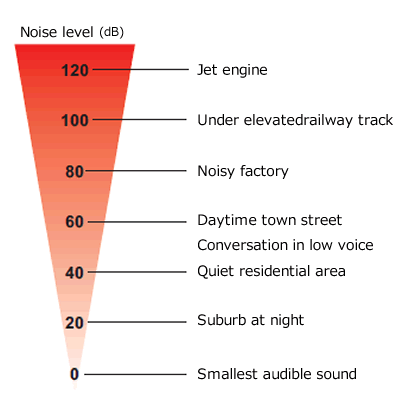 Figure 2-1: Typical noises and their levels Figure 2-1: Typical noises and their levels |
3. Noise classification
Noise changes can be divided into level fluctuations on the time axis and spectral composition differences on the frequency axis, and noise can be classified accordingly.
| NOTE:This chapter is based on extracts from Annex F of JIS Z 8733:2000 “Noise classification based on spectrum and time variation of level” (ISO 12001). |
3.1 Noise classification based on temporal variation of level
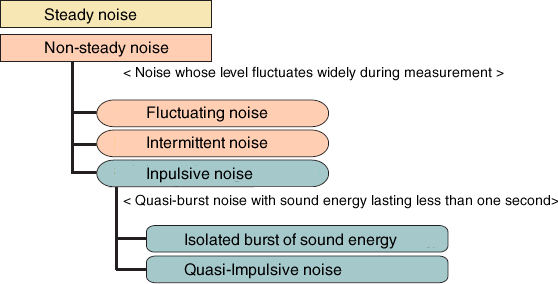 |
These types of noise have the following characteristics and typical time axis waveform.
| Stable noiseSteady noise is noise that has a nearly uniform level at the measurement point, with no or slight fluctuations in the meter reading. | 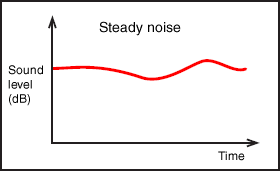 Figure 3-1 Figure 3-1 |
| Oscillating noiseFluctuational noise is noise that has a fairly wide and irregular fluctuation level at the measurement point. A typical example is noise measured near a road with a certain traffic volume. | 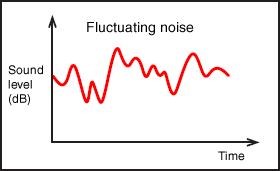 Figure 3-2 Figure 3-2 |
| Intermittent noiseIntermittent noise is noise that occurs at intervals, with each interval lasting more than a few seconds. Some intervals are fairly regular while others are irregular, such as when trains and planes pass by. | 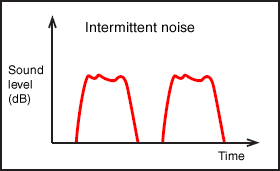 Figure 3-3 Figure 3-3 |
| An isolated burst of sonic energyImperative noise is an isolated burst of sound energy, a typical example being a pile driver. Some are single bursts while others occur intermittently. Some remain at roughly the same level while others fluctuate widely. What are commonly referred to as isolated bursts of sound energy occur at intervals of 0.2 seconds or more. | 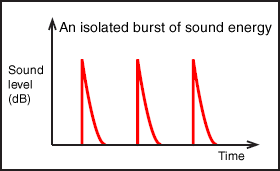 Figure 3-4 Figure 3-4 |
| Almost stable impulse noiseSemi-steady impulsive noise occurs at extremely short intervals (less than 0.2 seconds) while remaining at approximately the same level, examples include bells and rock drills. There are many cases where semi-steady impulsive noise is considered steady noise. | 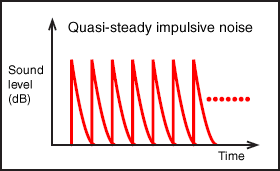 Figure 3-5 Figure 3-5 |
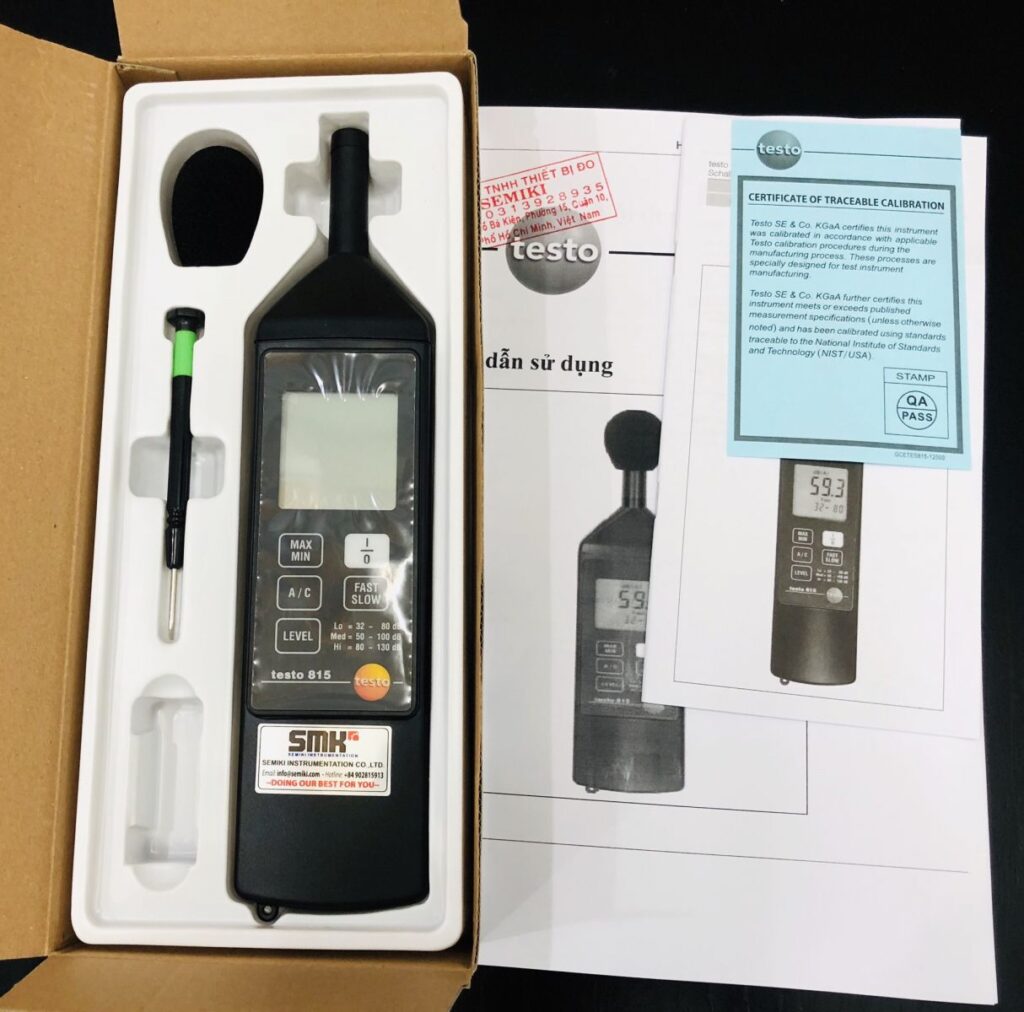
3-2 Noise Classification Based on Frequency Spectrum
Noise can be classified into the following three types based on the shape of the spectrum on the frequency axis.
 |
These types of noise have the following characteristics and typical spectral waveforms.
| Broadband noiseBroadband noise has a spectral form with sound energy distributed over a relatively wide frequency range. For example: falling sound, air conditioner vent sound, highway noise, etc. | 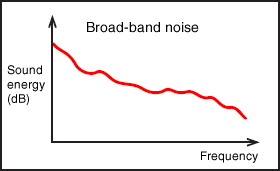 Figure 3-6 Figure 3-6 |
| Narrowband noiseNarrowband noise has a spectral shape with the sound energy concentrated in a relatively narrow frequency range (in the 1/3 octave range) and has no distinct timbre. Examples: distant thunder (low frequency), wind blowing through a meadow or ravine (mid frequency), the sound of air escaping from a tire (high frequency), etc. | 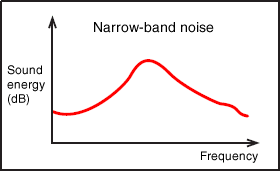 Figure 3-7 Figure 3-7 |
| Fragmented ToneDiscrete sound has periodic sound pressure fluctuations with a sense of pitch and frequency spectrum. For example: the hum of a fan, the beep from a digital device, the sound of a musical instrument, etc. | 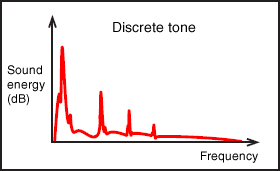 Figure 3-8 Figure 3-8 |
SEMIKI is a leading company in the market providing noise testing system solutions, sound analysis in the electronics, automobile, mechanical manufacturing industries... Semiki products can support many requirements of famous manufacturing plants.
CONTACT:
SEMIKI Measuring Equipment Company Limited
Email: sales@semiki.com
Phone: +84 9797 61016